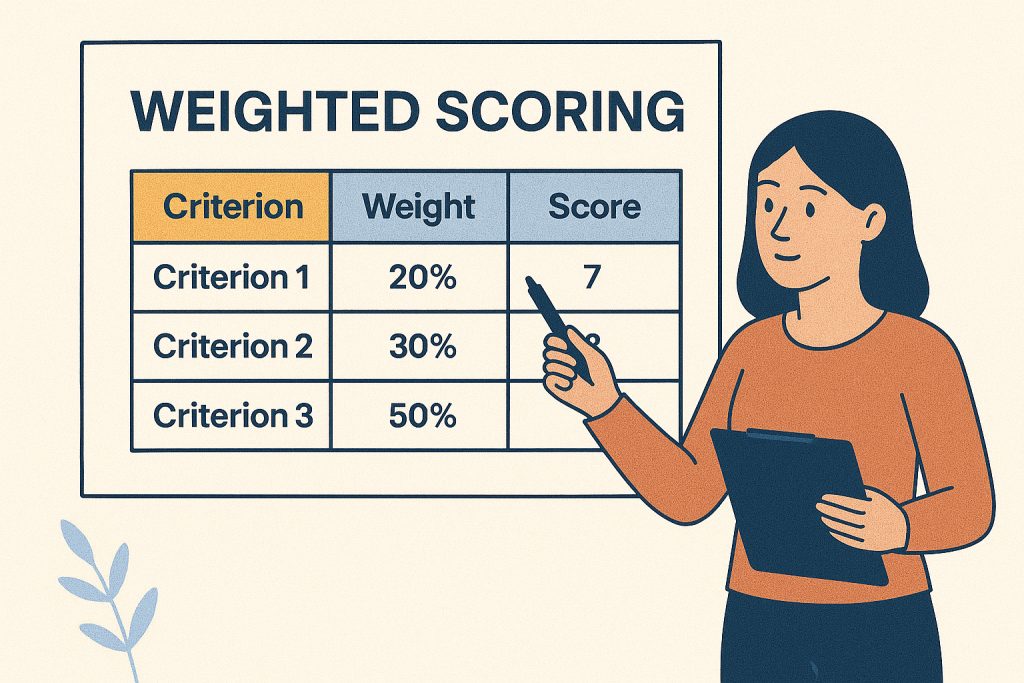In the fast-paced world of product development, teams face an endless stream of feature requests, bug fixes, and strategic initiatives competing for limited resources. The challenge isn’t identifying good ideas—it’s determining which ideas deserve immediate attention and which can wait. This is where weighted scoring emerges as a powerful ally, transforming subjective decision-making into a data-driven process that aligns teams around clear priorities.
Weighted scoring represents more than just another prioritization framework; it’s a systematic approach to evaluating competing initiatives through the lens of both potential benefits and implementation costs. Unlike simple ranking exercises that rely on gut feelings or loudest voices, this methodology assigns numerical values to specific criteria, creating transparency in how decisions are made and why certain features rise to the top of the roadmap.
How is weighted scoring used?
At its core, weighted scoring operates on a fundamental principle: not all evaluation criteria carry equal importance. Just as a teacher might assign greater weight to a final exam than a pop quiz, product teams must recognize that some factors matter more than others when evaluating potential initiatives. This nuanced approach acknowledges that context matters—what’s crucial for an early-stage startup differs significantly from what drives value for an established enterprise.
The framework’s strength lies in its flexibility and objectivity. Rather than relying on heated debates or political maneuvering, teams can channel their discussions into defining clear criteria and appropriate weightings. This process naturally surfaces strategic assumptions and forces alignment on what truly matters for the business at its current stage.
Consider a software company evaluating three potential features: a shopping cart system, enhanced user onboarding, and advanced analytics dashboards. Without a structured approach, teams might gravitate toward the most technically interesting option or the feature requested by the largest client. Weighted scoring forces a more holistic evaluation, considering factors like implementation complexity, revenue impact, and strategic alignment.
How do you calculate weighted scoring?
Implementing weighted scoring requires careful attention to both the criteria selection and the mathematical execution. The process begins with assembling a comprehensive list of initiatives under consideration—everything from major feature releases to infrastructure improvements and user experience enhancements.
Next comes the critical task of defining evaluation criteria. These typically fall into two categories: benefits the initiative might deliver and costs associated with implementation. Benefits might include metrics like increased user engagement, revenue growth potential, or competitive differentiation. Costs encompass not just development time but also ongoing maintenance, technical debt implications, and opportunity costs of not pursuing alternatives.
The weighting phase demands honest reflection about current business priorities. A company in growth mode might assign higher weights to user acquisition metrics, while a mature organization might prioritize revenue optimization or operational efficiency. These weights aren’t permanent fixtures—they should evolve as business circumstances change.
Here’s how the scoring process typically unfolds:
- Criteria Definition: Establish 4-6 key factors that encompass both benefits and costs
- Weight Assignment: Allocate percentage values to each criterion based on current strategic priorities
- Individual Scoring: Rate each initiative on a consistent scale (often 1-10) for every criterion
- Calculation: Multiply individual scores by their respective weights and sum for final rankings
How do you analyze weighted scoring results?
The beauty of weighted scoring becomes most apparent when examining the results. The numerical outcomes often reveal insights that weren’t immediately obvious during initial discussions. A feature that seemed like an obvious priority might rank lower than expected when implementation costs are properly weighted, while a seemingly minor enhancement could emerge as surprisingly valuable when evaluated holistically.
This analytical phase requires teams to look beyond the raw numbers and understand the story they tell. Wide score gaps between initiatives suggest clear prioritization decisions, while clusters of similar scores might indicate the need for additional evaluation criteria or closer examination of specific factors. The process often highlights assumptions that need validation or reveals initiatives that deserve deeper investigation.
Most importantly, the scoring results should spark meaningful conversations rather than end them. When a beloved feature ranks poorly, teams should explore whether the scoring criteria accurately reflect current priorities or if the feature’s benefits haven’t been properly captured. Similarly, high-scoring initiatives that feel counterintuitive might signal shifting strategic needs that deserve attention.
How can product managers use weighted scoring?
Product managers operating in resource-constrained environments find weighted scoring particularly valuable for navigating competing stakeholder demands. The framework provides a structured approach that moves beyond political influence or the squeakiest wheel getting the grease. Instead, it creates a systematic method for evaluating features against consistent criteria.
The methodology proves especially powerful when dealing with cross-functional teams that bring different perspectives to prioritization discussions. Engineering teams might emphasize technical feasibility and maintenance costs, while sales teams focus on revenue potential and customer requests. Marketing might prioritize features that enhance competitive positioning or support key messaging. Weighted scoring provides a common language for these diverse viewpoints.
In practice, successful product managers use weighted scoring as part of a broader prioritization toolkit rather than a standalone solution. The framework works best when combined with qualitative insights, market research, and strategic planning. It’s particularly effective for medium-term roadmap planning where teams need to balance multiple factors without getting overwhelmed by analysis paralysis.
- Stakeholder Alignment: Creates transparency in how prioritization decisions are made
- Strategic Focus: Forces teams to articulate what matters most at their current stage
- Objective Discussion: Moves debates from opinion-based to criteria-based conversations
Why use a benefits vs. costs lens when conducting weighted scoring?
The dual focus on benefits and costs reflects the fundamental reality of product development: every decision involves trade-offs. No team has unlimited resources, and even the most valuable features require investment of time, money, and opportunity costs. A benefits-only approach might lead to wishful thinking, while a costs-only perspective could result in choosing the cheapest rather than the most valuable options.
This balanced lens forces teams to grapple with difficult questions about return on investment. A feature might offer tremendous user value but require six months of development time that could be spent on three smaller improvements. Conversely, a technically simple enhancement might deliver minimal benefits despite its ease of implementation. The benefits versus costs framework ensures these trade-offs remain visible throughout the evaluation process.
The approach also helps teams avoid common prioritization pitfalls. Without considering costs, teams might consistently choose ambitious features that never ship due to scope creep or technical complexity. Without weighing benefits, they might focus solely on what’s easiest to build rather than what creates the most value. The dual perspective maintains healthy tension between ambition and pragmatism.
Moreover, this framework scales naturally as organizations grow. Startups might emphasize speed to market and user validation, while enterprise companies could weight factors like scalability and compliance more heavily. The underlying structure remains constant while the specific criteria and weightings adapt to changing circumstances.
Next Steps
Implementing weighted scoring successfully requires commitment to the process and willingness to iterate on the approach. Teams should start with a manageable number of initiatives and criteria, learning from each evaluation cycle to refine their methodology. The goal isn’t perfect precision but rather more thoughtful and transparent decision-making.
Regular calibration sessions help ensure the scoring criteria and weights remain aligned with evolving business priorities. What matters most for a company today might shift significantly as market conditions change or the organization reaches new growth stages. Treating weighted scoring as a living framework rather than a static tool maximizes its long-term value.
Teams should also resist the temptation to over-engineer their scoring systems. While it’s possible to create elaborate frameworks with dozens of criteria and complex mathematical relationships, simpler approaches often prove more practical and sustainable. The best scoring system is one that teams actually use consistently rather than one that looks impressive in presentation slides.
When implemented thoughtfully, weighted scoring transforms prioritization from a source of endless debate into a structured process that builds team alignment while maintaining flexibility for changing circumstances. The methodology doesn’t eliminate the need for judgment—instead, it channels that judgment into more productive discussions about what matters most and why. Teams discover that the most valuable aspect often isn’t the final scores themselves, but rather the conversations and insights that emerge during the evaluation process. By making previously implicit assumptions explicit and forcing alignment on evaluation criteria, weighted scoring creates a foundation for more strategic decision-making that extends far beyond individual feature choices.
Conclusion
Weighted scoring offers product teams and organizations a powerful tool for cutting through the noise of competing priorities and making decisions based on clear, quantifiable criteria. While it requires upfront investment in defining meaningful metrics and honest assessment of strategic priorities, the payoff comes in the form of more objective decision-making and better alignment across stakeholders. The key to success lies not in the mathematical precision of the scores themselves, but in the quality of thinking that goes into designing the framework and the discipline to regularly reassess whether it still reflects what truly matters for the business.


